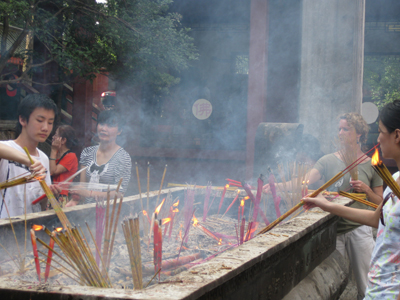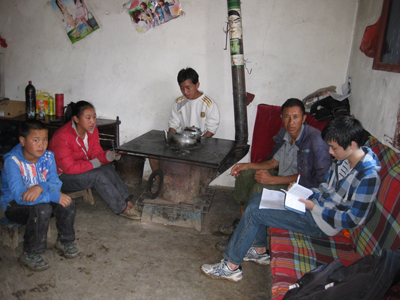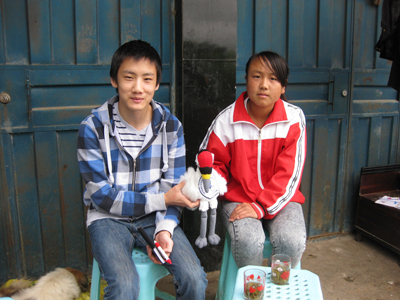
By Kevin Li
Editor’s note: Kevin is a high school junior in Wisconsin and is the son of ICF’s China Program Coordinator, Dr. Li Fengshan. Kevin recently visited Caohai Nature Reserve, a critical wintering area for Black-necked Cranes in southwest China, to learn about ICF’s One Helps One Program. Through this program, students are paired with a sponsor, who provides an annual donation to help cover their school costs, including tuition, books, supplies, and uniforms.
Following is an excerpt from Kevin’s report on his visit to Caohai, describing two students who are currently sponsored through the One Helps One Program. To learn more about the program or to become a sponsor, please contact ICF at info@savingcranes.org.
Photo: Kevin (far left) learned about the people and cultures of southwest China during his visit to Guizhou Province this summer, including visiting a Buddhist temple in Guiyang.
This summer, I had the chance to go to Caohai and talk with many of the girls who are part of the One Helps One Program and learn about their families, schools, hobbies, and their plans for the future. The One Helps One Program was started by the International Crane Foundation (ICF) and the Caohai Nature Reserve in southwest China to help keep girls in school. Caohai is one of the poorest places in China, and because of this many girls have to drop out of school in order to help support their families. Girls are chosen for this program with the hope that they will stay in school longer, which in turn will increase their chances of obtaining better jobs, earning more money, and having smaller families.

The first girl I visited was Zhu Mei Qin, a 17 year old who recently finished her last year of middle school and will be attending a technical high school in September. Zhu Mei Qin’s goal is to earn a degree in cooking and become a chef. She has been in the One Helps One Program for six years, and was originally chosen by the Caohai Nature Reserve because of her disabled hand. She lost her right thumb in an accident when she was much younger. Due to her disability, she was not allowed to study to become a preschool and kindergarten teacher. She really enjoys school and wanted to go to a regular high school and attend college, but was not able to do this due to her grades. Even though she won’t be able to go to college, she is working hard and helps cook every day for her family.
Photo: Kevin (far right) with Zhu Mei Qin (second from left), her brother (center), and father (seated next to Kevin).
I also was able to speak with her father and learned a bit about their family situation. Their family owns half an acre of cropland, and they grow cabbage and corn depending on the season. In a year Zhu Mei Qin’s family makes around 20,000 RMB, which is about the equivalent of $4,300. For Zhu Mei Qin to attend high school, it costs around 7,000 RMB (about $1,100), which includes tuition fees, uniforms, book costs, and food costs, but does not include the cost of living on campus if she were to do so. For her brother to attend college, it costs 10,000 RMB for just his tuition fees. The cost of just Zhu Mei Qin and her brother to attend high school and college is about the same as their family makes in a year. School scholarships and money loaned from their local Community Trust Fund, a village lending system, help the family with these expenses, but it is still difficult to pay for their children’s education along with their normal household needs.

The next girl I talked with was Zhu Tiao, who is 14 years old and will be in her 3rd year of middle school this September. She was chosen for the One Helps One Program because of how well she does in school, and she has been sponsored for three years. She really enjoys school and hopes to attend a good high school in the city and then a good college. Every day she walks to Bai Ma School, which is about 2 km away and about a 20 minute walk, with classes starting at 8 am. In her class there are around 70 students. Unlike in the United States, middle and high schools students in China have just one classroom where they stay all day and the teachers move around to different classes to teach. At 12:30 pm classes finish for a 1.5 hour lunch break. During this time students usually go home to eat lunch and maybe take a short nap before going back to school to attend classes until 5 pm. After school, she returns home and helps her family with chores, such as cleaning or cooking. After dinner she helps clean up and then does homework, however she says there is not much school work generally and usually she studies more after she finishes her homework. During her free time, Zhu Tiao said she enjoys playing basketball with her friends and she also enjoys running.
Photo: Kevin and Zhu Tiao pose with Archie, a plush Whooping Crane that traveled with Kevin to Caohai as an ICF ambassador (click here to learn more about Archie’s travels).
